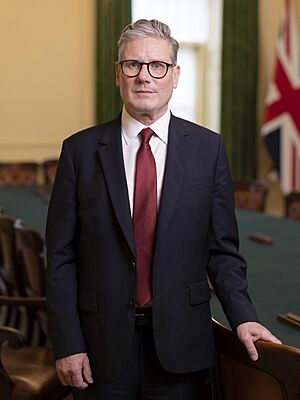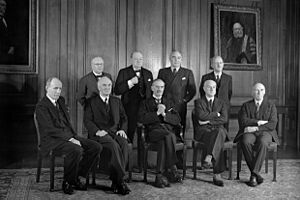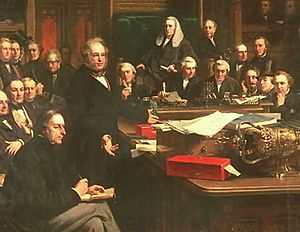Prime Minister of the United Kingdom facts for kids
Quick facts for kids Prime Minister of the United Kingdom of Great Britain and Northern Ireland |
|
|---|---|

|
|
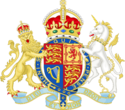
|
|
|
|
| Style |
|
| Member of |
|
| Reports to | |
| Residence |
|
| Appointer | The Monarch
(with their choice limited to the person who can command the confidence of the House of Commons)
|
| Term length | At His Majesty's pleasure |
| First holder | Sir Robert Walpole |
| Deputy | No fixed position; often held by: |
| Salary | £166,786 per annum (2024) (including £91,346 MP salary) |
The prime minister of the United Kingdom is the main leader of the UK government. They advise the King or Queen on important decisions. The prime minister also leads the Cabinet, which is a group of top government ministers. They choose who gets to be a minister.
To be prime minister, a person must have the support of the House of Commons. This means they are almost always a Member of Parliament (MP). Usually, the prime minister is the leader of the political party with the most seats in the House of Commons.
The job of prime minister isn't set up by a single law. Instead, it has grown over a long time through traditions. The prime minister is also known as the First Lord of the Treasury. They are also in charge of the Civil Service and national security. The prime minister's official home and office is 10 Downing Street in London.
The prime minister's power has grown a lot since the first one, Robert Walpole, in 1721. They play a very important role in British politics. Leaders like Margaret Thatcher and Tony Blair had a lot of power. Their time in office was sometimes called "presidential." This was because they had strong control over the government.
Today, the prime minister is one of the world's most powerful political leaders. The UK has the world's sixth-largest economy. This gives the prime minister a big role both at home and around the world. The UK is also a key member of groups like NATO, the G7, and G20.
As of July 2025, 58 people have been prime minister. This includes 55 men and 3 women. The first was Robert Walpole, who started on 3 April 1721. Walpole was also the longest-serving prime minister, serving over 20 years. The shortest-serving was Liz Truss, who was in office for only seven weeks. Keir Starmer became prime minister on 5 July 2024. He took over from Rishi Sunak after the 2024 general election.
Contents
How the Prime Minister's Role Developed
The job of prime minister wasn't created all at once. It slowly changed over 300 years. Many laws, political changes, and historical events shaped it. It's hard to say exactly when the job began.
Early Beginnings: 1689–1742
The 17th century was a time of big change in Britain. There were wars and conflicts between the King and Parliament. This led to the end of kings having total power. In 1688–1689, the Glorious Revolution happened. This made William III and Mary II constitutional monarchs. This meant their power was limited by laws.
Laws like the Bill of Rights gave Parliament more power than the King. During this time, two main political groups formed: the Whigs and the Tories. The Whigs supported Parliament's power. The Tories favored the King's power.
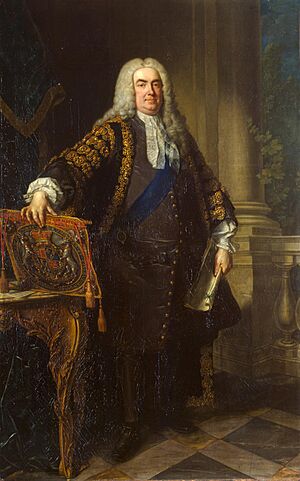
In 1707, the Acts of Union created the Kingdom of Great Britain. The Parliament of Great Britain gained control over the country's money. The term 'prime minister' started to be used around this time. Since 1721, the person holding this role was also usually the First Lord of the Treasury. This role became more important over time.
In 1714, George I became King. He wasn't very interested in governing. He left much of the work to his ministers. In 1720, a financial crisis called the South Sea bubble happened. Many government officials were involved. After this, Sir Robert Walpole became First Lord of the Treasury in 1721.
Sir Robert Walpole is seen as the first "de facto" (meaning in practice) prime minister. He had a lot of influence over government decisions. He served from 1721 to 1742. His time in office was called the "Robinocracy." Walpole was good at managing money after the South Sea Bubble. He kept peace, lowered taxes, and reduced national debt. He also managed Parliament very well.
Walpole's time in office was key to shifting power to the House of Commons. It also helped set up the modern Cabinet system. Even though he held power for 20 years, he faced challenges. He resigned in 1742 after a bad war with Spain.
Growing the Role: 1742–1945
After Walpole resigned, several different governments quickly followed. Between 1742 and 1760, there were five different governments. Spencer Compton, Earl of Wilmington became prime minister. But he only served a short time. The government faced struggles over Britain's involvement in wars.
What Powers Does the Prime Minister Have?
The prime minister has many important powers. They lead the government and the Cabinet. They also lead a major political party. This usually means they have a majority of support in the House of Commons.
Leading the Government
The prime minister is the head of the UK government. They lead the Cabinet, which is the executive part of the government. The prime minister also leads their political party. This gives them a lot of power to make laws and carry out government plans.
The prime minister is responsible for the government's actions. They work with Cabinet ministers to make decisions. This helps make sure that power is shared and not just held by one person. The prime minister must always have the support of the House of Commons. If they lose this support, they might have to resign or call a new election.

The prime minister is the main advisor to the King or Queen. While the King or Queen has some powers on paper, in reality, the prime minister and Cabinet make most decisions. This is part of how the UK's constitutional monarchy works. The King or Queen "reigns but does not rule."
The prime minister also has special powers called "prerogative powers." These include making foreign policy and national security decisions. For example, they can declare war or send troops. However, they usually need Parliament's approval for military action. The prime minister also influences public policy. This is because they lead the largest party in government.
Making Laws
In the House of Commons, the prime minister guides the process of making laws. Their goal is to pass the laws their political party wants. The prime minister chooses all other Cabinet members and ministers. They also coordinate what all government departments do.
The prime minister is the public "face" and "voice" of the government. They represent the UK at home and abroad. The King or Queen makes many important appointments based on the prime minister's advice. This includes judges, political leaders, and church leaders. They also advise on giving out honors like knighthoods.
The prime minister has a lot of influence over new laws. They control the Cabinet and lead the biggest political party in the House of Commons. This helps them guide laws that fit their party's goals. Their power has grown a lot since World War II. Now, the prime minister directly oversees government bills.
The prime minister can also make sure laws get passed by keeping their party united. If their party has a majority, they can pass laws with little trouble. This is often done with the help of "Whips." Whips make sure MPs stay loyal and vote with the government. The prime minister also shapes policies before they even reach Parliament.
Working with Parliament
The prime minister's power in Parliament comes from old traditions and laws. The job itself isn't written into parliamentary law. It has developed over centuries through customs. The prime minister controls the Cabinet. They also influence what laws are discussed in Parliament. They can do this by keeping their party's MPs voting together.

Another key power is choosing who is in the Cabinet. The prime minister not only picks Cabinet members but also leads their meetings. They decide when meetings happen and what topics are discussed. This helps them guide decisions in the direction they want. The prime minister also controls Parliament's schedule. They can decide how much time is given to government bills.
The prime minister's parliamentary powers also include foreign relations. They represent the government on the world stage. This includes discussing treaties and international agreements in Parliament.
Special Powers: Prerogative Powers
The most important powers of the prime minister are "prerogative powers." These are special rights that used to belong to the King or Queen. Over time, they became powers used by the prime minister and the government. These powers allow the prime minister to act without Parliament's direct approval in some cases. This includes declaring war, sending troops, and giving out honors.
These powers let the prime minister act on behalf of the King or Queen. This happens in situations where there isn't a specific law or tradition. Foreign affairs are a key area for these powers. For example, in 2003, Prime Minister Tony Blair sent British troops to Iraq. He did this without immediate approval from Parliament.
However, there are growing calls for more checks on these powers. People want more transparency and accountability. Courts have also started to look closely at how these powers are used. This shows a tension between old traditions and the need for modern accountability.
How the UK Government Works
The British government system has an "uncodified constitution." This means it's not written in one single document. Instead, it's made up of many documents and, most importantly, old customs. These customs are called "constitutional conventions." They have become accepted ways of doing things.
The relationships between the prime minister, the King or Queen, Parliament, and the Cabinet are mostly based on these unwritten rules. Many of the prime minister's powers actually come from the King or Queen's old "royal prerogatives." Even though the prime minister has become very powerful, the idea used to be that the King or Queen still governed directly.
The job of prime minister was first mentioned in a law in 1917. This was in the Chequers Estate Act. Over the 20th century, the prime minister's role appeared more in laws and official papers. But their powers still mostly come from old royal rights and traditions. Prime ministers are also the First Lord of the Treasury and the Minister for the Civil Service. This gives them power over the civil service.
The UK system might seem to have two leaders: the prime minister and the King or Queen. But this is solved by the idea of "the Crown." The Crown represents the state's power to govern. Before 1688, the King or Queen had all these powers. After the "Glorious Revolution" of 1688, Parliament slowly made monarchs take a neutral role. Parliament gave the Crown's powers to responsible ministers. These ministers, like the prime minister and Cabinet, are accountable to Parliament.
Even though the King or Queen still has many powers on paper, traditions mean they don't get involved in daily governing. The King or Queen has three main rights: to be kept informed, to advise, and to warn.
The Modern Prime Minister
Today, how a prime minister is chosen is mostly based on traditions. These rules are described in official guides like The Cabinet Manual.
How a Prime Minister is Chosen
The King or Queen officially appoints the prime minister. In the past, the King or Queen could choose or dismiss a prime minister. But now, it's a tradition that the King or Queen stays out of party politics.

If a prime minister or their party wins a general election, they usually get a majority of seats in the House of Commons. The King or Queen then invites them to form a new government. The prime minister goes to Buckingham Palace to meet the King or Queen. This meeting is a moment for the prime minister to promise loyalty. It's also when they are officially asked to lead the government. This ceremony is sometimes called "kissing hands."
The prime minister holds their job because they have the support of the House of Commons. This support comes from the voters in a general election. By tradition, the prime minister is also an MP. They are usually the leader of the political party that has the most seats in the House of Commons.
The Prime Minister's Office
The Prime Minister's Office helps the prime minister lead the government. It helps them set and achieve their goals. It also helps them share government policies with Parliament, the public, and other countries. The Prime Minister's Office is part of the Cabinet Office.
The Prime Minister's Office was officially created in 1916. This happened during World War I under David Lloyd George. It was the first time the prime minister's office was formally recognized. It became a separate part of the government. This was needed to help manage the country during wartime.
Prime Minister's Questions
Prime Minister's Questions (PMQs) is a long-standing tradition. It happens every Wednesday at noon when the House of Commons is meeting. During PMQs, the prime minister answers questions from Members of Parliament (MPs).

The leader of the opposition usually asks six questions. The leader of the third-largest party can ask two questions. PMQs is shown live on TV and radio. This makes it a very public event.
The modern form of PMQs started in 1961. The timing of PMQs has changed over the years. This often depended on the prime minister's schedule. In 1989, PMQs was first broadcast. In 1990, it was broadcast live. This was done to make the government more open and accountable.
The prime minister also meets with the Liaison Committee. They answer questions about government policy there.
Security and Travel
The Metropolitan Police Service protects the prime minister. This includes current and former prime ministers. When the prime minister lives at 10 Downing Street, armed police are always there. There are also security checkpoints and patrols. This security was increased due to threats in the past.
When the prime minister travels, a team of police officers and security personnel goes with them. On the road, police motorbikes clear the way for their cars. The prime ministerial cars have many security features. They are custom-made and British-built. They have special features like gun ports and an independent oxygen supply. The prime minister also uses military and civilian planes for air travel.
International Role
One of the prime minister's jobs is to represent the UK around the world. For example, they attend the annual G7 Summit. The prime minister makes many international trips. The number of overseas visits has increased over time.
Deputy Prime Minister
Prime ministers sometimes have a deputy. This might be an official deputy prime minister or another senior minister. Some prime ministers don't choose a specific deputy.
The role of deputy prime minister is not set by law. It has often been created when needed. For example, Clement Attlee was unofficially deputy prime minister during World War II. He helped manage domestic affairs while Winston Churchill focused on the war.
After the 2010 general election, a coalition government was formed. David Cameron (Conservative) and Nick Clegg (Liberal Democrat) led it. Clegg served as deputy prime minister. He chaired Cabinet meetings and led important negotiations. This made the role more formal during his time.
What Happens if a Prime Minister Dies?
There is no automatic rule for who takes over if a prime minister dies suddenly. There is also no official title like "acting prime minister." The King or Queen would choose a very senior government member to be a caretaker prime minister. This person would likely be someone acceptable to the Cabinet. Once the ruling party chooses a new leader, that person would become the new prime minister.
When the prime minister travels, a senior minister is usually appointed to handle urgent business. However, the prime minister remains in charge and stays updated. For example, in April 2020, when Boris Johnson was ill, he asked Dominic Raab to act on his behalf when needed.
Resigning from Office
A prime minister leaves office by giving their resignation to the King or Queen. This can happen if their party loses a general election. It can also happen if they are forced to resign for political reasons or due to illness.

If a prime minister resigns mid-term but their party still has a majority, the party chooses a new leader. The King or Queen then invites this new leader to become prime minister. The outgoing prime minister usually stays until the new leader is chosen. After resigning, they remain a Member of Parliament.
Outgoing prime ministers can ask the King or Queen to give honors to people they choose. This is called Prime Minister's Resignation Honours. No prime minister has ever lost their own seat in a general election while in office. Only one prime minister has been assassinated: Spencer Perceval in 1812.
Special Benefits and Titles
When a new prime minister takes office, they usually make a public statement. They announce that the King or Queen has asked them to form a government.
Titles and How to Address the Prime Minister
The title "prime minister" was first officially used in government records in 1885. In 1904, the official Imperial Calendar listed the prime minister as "Prime Minister and First Lord of the Treasury."
In the UK, the prime minister is ranked very high. They are above almost all other important people, except members of the royal family. The prime minister was officially given a place in the order of importance in 1905. The Chequers Estate Act 1917 was the first law to mention the prime minister.
The prime minister is usually a member of the Privy Council. This means they are called "The Right Honourable." Once someone is a member, they stay a member for life. It's a tradition that only a Privy Counsellor can become prime minister.
The prime minister should be called "the prime minister." Using "Prime Minister Keir Starmer" is common in news reports. However, "Prime Minister Starmer" is not used in the UK.
Salary and Pay
In 2010, the prime minister received an extra £14,500 on top of their MP salary of £65,737. Until 2006, the lord chancellor was the highest-paid government member. This changed after the Constitutional Reform Act 2005.
During Gordon Brown's time as prime minister, the salary was £193,885 in 2009. As of 2024, it is £166,786. This reduction happened because Brown cut voluntary pay. Later prime ministers have kept this lower pay.
Official Homes
10 Downing Street in London has been the prime minister's official home since 1732. They can use its staff and offices. King George I first gave the building to Robert Walpole, the first prime minister. Walpole said he would only accept it for the First Lord of the Treasury. This meant future prime ministers could also live there. The building complex includes No. 11 and No. 12 Downing Street. Together, they have over 100 rooms.
Chequers is a country house in Buckinghamshire. It was given to the government in 1917. The prime minister can use it as a country retreat. It was donated so the prime minister could have a quiet place to relax.
In the 18th and 19th centuries, many prime ministers were from noble families. They owned large country estates. They also had homes in London for political work. Until the mid-20th century, Parliament had long breaks. This gave prime ministers plenty of time to rest.
After Being Prime Minister
Retirement Honors
When a prime minister retires, the King or Queen usually gives them an honor. This is often membership in the Order of the Garter, a very important order of chivalry. If a prime minister is Scottish, they might receive the Order of the Thistle instead.
Historically, prime ministers were also often given a peerage. This would make them a member of the House of Lords. The last time this happened was for Harold Macmillan in 1984. He became Earl of Stockton over 20 years after leaving office.
More recently, prime ministers like Alec Douglas-Home, Harold Wilson, James Callaghan, Margaret Thatcher, David Cameron, and Theresa May accepted life peerages. This means they became members of the House of Lords for life. Some former prime ministers, like Edward Heath, John Major, and Tony Blair, were appointed as Knights Companion of the Garter.
What Former Prime Ministers Do
There are no set jobs for former prime ministers. What they do depends on their personal choices. In the 18th and 19th centuries, many wealthy former prime ministers simply retired to their country estates. Some, like Robert Walpole, became very rich while in office. Others, like William Pitt the Elder, had large debts that Parliament later paid off. In 1937, a pension for former prime ministers was introduced.
Many former prime ministers write memoirs or autobiographies. Some have also written non-political books. For example, Winston Churchill wrote histories of World War II. Edward Heath wrote about sailing and music. John Major wrote about cricket.
In the 21st century, many former prime ministers have started their own foundations or charities. They use these to stay involved in political and public issues. Margaret Thatcher started her own foundation in 1991. Tony Blair has set up a sports foundation and an inter-faith foundation. He also started the Tony Blair Institute for Global Change. Blair was also the first prime minister to take on a major international role after leaving office.
Some former prime ministers have even returned to serve in later governments. For example, the Duke of Wellington served in two governments after his own time as prime minister. Arthur Balfour served as Foreign Secretary for eleven years after being prime minister. Neville Chamberlain served in Winston Churchill's war cabinet after resigning as prime minister in 1940.
Public Duty Costs Allowance
All former prime ministers can claim money for office expenses. This money helps them carry out public duties related to their former role. It cannot be used for private or parliamentary duties.
The maximum amount they can claim is £115,000 per year. This limit is reviewed every year. The current prime minister can adjust it. If a former prime minister gets public money for other jobs, this allowance might be reduced. For example, David Cameron did not claim this allowance when he became Foreign Secretary in November 2023.
More About Prime Ministers
Lists of Prime Ministers
- Timeline of prime ministers of Great Britain and the United Kingdom
- List of prime ministers of the United Kingdom
- List of prime ministers of the United Kingdom by length of tenure
- List of prime ministers of the United Kingdom by age
- List of prime ministers of the United Kingdom by education
- List of current heads of government in the United Kingdom and dependencies
- List of fictional prime ministers of the United Kingdom
- List of peerages held by prime ministers of the United Kingdom
- List of United Kingdom Parliament constituencies represented by sitting prime ministers
- Historical rankings of prime ministers of the United Kingdom
Other Related Pages
- Air transport of the British royal family and government
- Spouse of the prime minister of the United Kingdom
- Records of prime ministers of the United Kingdom
- Deputy Prime Minister of the United Kingdom
- Cultural depictions of prime ministers of the United Kingdom
- List of things named after prime ministers of the United Kingdom
- List of nicknames of prime ministers of the United Kingdom
- Armorial of prime ministers of the United Kingdom
- List of burial places of prime ministers of the United Kingdom
See also
 In Spanish: Primer ministro del Reino Unido para niños
In Spanish: Primer ministro del Reino Unido para niños


